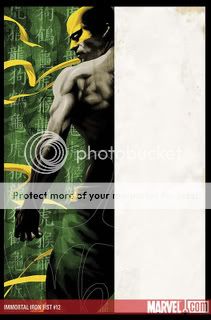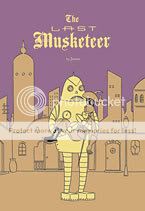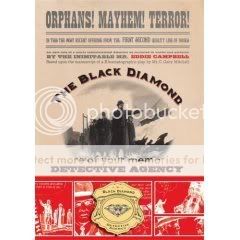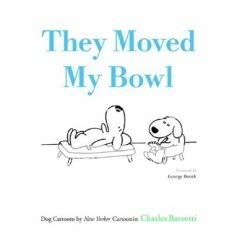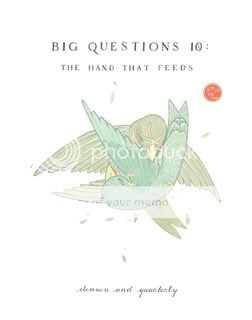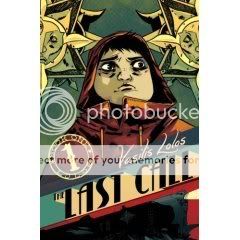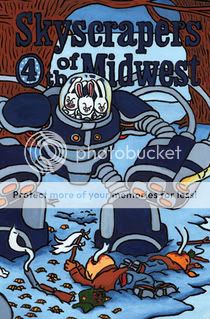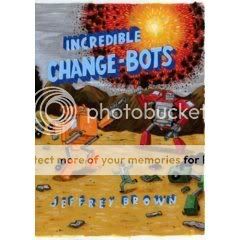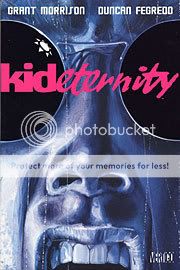Posts Tagged ‘Comics Time’
Comics Time: Mother, Come Home
February 8, 2008Mother, Come Home
Dark Horse, November 2003
Paul Hornschemeier, writer/artist
128 pages
$14.95
Buy it used through Amazon.com
Originally written on March 3, 2004 for publication by The Comics Journal
2003 saw the release of gargantuan tomes like Palomar, The Frank Book, and Blankets, so it might seem facetious to claim that the year’s most ambitious graphic novel was a 128-page paperback. But how else to describe Mother, Come Home, a book wherein author Paul Hornschemeier’s formidable formal mastery is harnessed to an even more consciously grand personal tragedy? This is the kind of storytelling that’s as likely to fall flat on its face as it is to fly. Hornschemeier’s willingness to throw the full weight of his skill into this task is what ensured the latter outcome.
Originally serialized in the author’s Forlorn Funnies series, a more narrative-minded follow-up to his experimental one-man anthology Sequential, Mother tells the story of Thomas Tennant, a preternaturally conscientious seven-year-old dealing with the death of his mother and his father’s subsequent disappearance into his own broken mind. Interstitial titles set up the conceit that the novel is merely the “introduction” to a larger work, the first “chapter” of which is to be called “We Are All Released.” In this alone–that is, in grafting an unnecessarily complex framing device onto the story in order to deliver the four-word message of hope at the book’s end–Hornschemeier’s artistic fascination with the tension between control and freedom is evident.
It’s a tension that’s at work on every page. The cartoonist’s considerable skill in graphic design manifests itself in a panoply of geometric intra-panel layouts–boxes bisected by a furrowed brow, the edge of a door, the bend of a telephone receiver. It’s not specific images that stand out upon reflecting on Hornschemeier’s art, but unexpected diagonals and rounded corners, a sort of poetry of shape. But when Thomas retreats into his fantasy life, this everything-in-its-right-place precision is forgone for scratchy, simplistic, childlike linework. The escape Thomas plans for his father is made manifest in the boy’s own dreams.
Much has been made about Hornschemeier’s skill as a colorist, and his work in that department is every bit as deft as you’ve heard, but his lettering merits special mention. Throughout the book, the characters’ words are subtly dwarfed by the word balloons that contain them. This simultaneously suggests a certain generosity of spirit, a yearning for something more than what is being expressed, and a recognition of the futility and smallness of language to deal with the immensity of the suffering going on beneath, and on, the surface. (And it does so on the parts of both the characters and the creator, by the way.) Individual moments linger, too: Within the father’s fantasy, it’s the comments that seem the most casual which expand to fill their entire panels, conveying a sort of frantic off-handedness that smacks also of denial; lower-case lettering slips off-line and expands in manic curlicues, perfectly conveying Thomas’s hysteria upon realizing he’s alerted his uncle to his father’s breakdown. Meanwhile, the simplicity of the captions’ lettering offsets the occasionally baroque prose (perhaps bulletproofing the book against the kind of criticism occasionally leveled at Craig Thompson’s similar linguistic stylings in Blankets).
What elevates the book from graphic-designers-gone-wild wankery, though, is the way these devices perfectly complement and convey the values of the narrative. As Thomas and his father’s family falls apart, the two of them adopt a succession of tactics–a lion mask, a retreat into solipsism, a rigorously followed “groundskeeping” routine, a residential treatment facility, methodical escape plans–to exert control over the unbearable chaos of their lives, precisely for the purpose of freeing them from it. The tension-breaking achieved on a formal level by Hornschemeier’s occasional insertion of exhilarating out-of-nowhere experimentation (the floating fantasy introduction; the full-page jacket-cover illustration for another book with a tendentious relationship to the story itself; the nighttime views of the book’s sleeping characters, from the most important to the most obscure) is echoed on the narrative plane by flashes of humor (Thomas’s hilarious smackdown of his teacher makes up for her somewhat unrealistic (and unforgivable) behavior) and immensely warm pathos (the exchanged glances between a smiling Thomas and a scowling nurse are worth the price of admission alone for their heartbreaking directness). It culminates in a climax that by all rights should seem ham-fisted and forced, and yet works, emerging as it does from intensely intimate (and therefore immediately understandable) details of touch and sight and (not) taste–tiny, sensate building blocks of calamitous inevitability. What hints of too-neat tragedy remain are torn to pieces by the book’s final words, and the forward-looking eeriness of the image that accompanies them.
Mother, Come Home is the work of a young cartoonist who, confident in his craft, decided to do something big with it. For his ambition alone–which, thankfully, is far more common amongst his cartoonist peer group then its reputation as a collection of coasting glad-handlers would have it–he is to be respected. For his success–his indelible, beautiful, and heartrending graphic novel, the type of book for which the phrase “auspicious debut” was invented–he is to be celebrated. His book is a joy to read; the fact that this is a feeling forbidden to the characters therein makes it all the sharper, and sweeter, and harder to forget.
Comics Time: Death Note Vol. 1
February 6, 2008Death Note Vol. 1
Viz, September 2005
Tsugumi Ohba, writer
Takeshi Obata, artist
Pookie Rolf, translator/adapter
200 pages
$7.99
It’s hard not to cackle with glee at how neatly Death Note fits into the scary-media pantheon, filling a slot previously occupied by Marilyn Manson, Beavis and Butt-Head, Bart Simpson, Grand Theft Auto, N.W.A., Natural Born Killers, Dungeons & Dragons, and so on all the way back to the days of Elvis Presley and EC Comics. The premise–a straight-A student discovers a death god’s notebook, and anyone whose name he writes in it dies–is practically guaranteed to send authorities into a Chicken Little panic. It’s not the world’s most artful effort: like most translated manga, scene transitions are awkward and dialogue comes out in weird little bursts, while the figurework is sturdy but pretty standard and the characters play comfortably to type.
But it shines in a couple of regards besides that initial, killer high concept. I really enjoy the way Obata spots blacks; they’re pitch dark and almost geometric, as though the page is occasionally partially posessed by a slightly greasier Mike Mignola. And they come together in the form of Ryuk, the death god whose comically lanky larger-than-life presence and googly-eyed, permanently grinning, static shock of a face is a continual source of chuckles for me in its ostentatious weirdness. The other highlight is Light, the model high-schooler who within a few hours of finding the death note has become an archcriminal capable of baffling the combined law enforcement agencies of the entire world with his plot to exterminate the global criminal underclass and force everyone else into good behavior via paranoia. I’ve grown reluctant to harp on sociopolitical messages in genre work, but the idea here seems to be that Japan’s insanely intense educational culture produces miniature sociopaths, and that’s just plain funny. Right now the cat-and-mouse games aren’t engaging in any visceral way–by way of contrast, I’m watching the first season of The Wire for the first time, and there’s just no comparison–but the whole thing just tickles me in much the same way that Light’s plans tickle Ryuk, so I’ll make my way through the whole series, I’m sure.
Comics Time: Dr. Seuss Goes to War: The World War II Editorial Cartoons of Theodor Seuss Geisel
February 4, 2008Dr. Seuss Goes to War: The World War II Editorial Cartoons of Theodor Seuss Geisel
The New Press, September 2001
Dr. Seuss, writer/artist
Richard H. Minear, editor
272 pages
$19.95
I have to admit that I personally find editorial and political cartoons to be a colossal, frequently distasteful waste of time and resources. 99.9 times out of 100 they’re just strident, unimaginative, button-pushing sermons to the choir. They’re intended not to enlighten or persuade but to flatten complex issues into images so reductive that they’re not just simplistic but frequently misleading or even mendacious in their representation of what’s being talked about–which really doesn’t matter, because the right people will applaud and the right people will be outraged. You have to be extraordinarily gifted to make a go of this field, and maybe half a dozen such artists in the history of the English-speaking world have had that knack.
As it turns out, Dr. Seuss was one of them. Prior to his enshrinement as the 20th century’s preeminent author-illustrator of children’s books, the then-struggling Geisel–prompted by a loathing of Fascism–was an editorial cartoonist for PM, a daily New York City newspaper that served as sort of an unofficial spokesorgan for the Leftist coalition called the Popular Front. But as editor Minear points out in his informative and readable text pieces that contextualize the cartoons in this volume, the good Doctor was more populist than Popular Front, and his war-era cartoons reflect a general sense of, if not quite Leftist, then left-leaning fair-play values. As such they are enormously refreshing to look at and read. Seuss passionately attacks the racist Jim Crow policies of the military and industry. He targets the anti-Semitism of Charles Lindbergh and the isolationist movement, including one memorable cartoon where his uniquely Seussian “eagle” (it’s impossible to look at this big-beaked, long-necked American mascot and not put the species in quotes) bears a placard reading “I AM PART JEWISH.” One pre-war cartoon even lumps Communists (with whom PM was basically okay) in with Nazis and Fascists as the joeys in the kangaroo pouch of America Firsters. In fact his earliest post-Pearl Harbor cartoons, of Dec. 8th and 9th 1941, seem to view the onset of war primarily as a rebuke to the benighted domestic forces of isolationism he and the progressives at PM were regularly targeting anyway.
Also exhilarating is his choice of imagery, which is deeply Seussian and totally alien to the usual played-out editorial-cartoon tropes. He makes surprising use of visuals indebted to horror and fantasy: On several occasions he portrays the Axis menace as massive sea serpents (as regular readers of this blog’s horror posts know, I’m a sucker for water monsters), and in his best anti-Japan cartoon a spokesman for the Empire mouthing civilized platitudes is revealed by the downward-drifting eye to be a Lovecraftian monstrosity with lobster claws and dragon’s feet. Similarly, one of his most memorable jabs at Hitler portrays the Fürher as a sword-wielding, horned-helmet and skull-and-swastika-wearing barbarian dictator seated in a shadowy cave lair atop a hill of skulls, sending out his Vichy lackey Pierre Laval to round up forced French labor.
The Japanese monster-man, of course, serves to highlight through contrast Seuss’s big weakness: His depiction of the Japanese enemy as a fungible assortment of slanty-eyed, buck-toothed, pig-nosed, coke-bottle-glasses-wearing stereotypes, even extending to the supposed fifth column of Japanese-Americans who he lampoons as waiting for instructions from home in one cartoon. In this he’s no different than pretty much every other American propagandist of the period, but it’s still a letdown given his sensitive and progressive treatment of American racism generally, and how artistically creative he gets with virtually every other facet of the war. Take his bestiary, for example: his unusual American eagle I’ve already mentioned, while he frequently represents Germany as a put-upon dachshund. Russia almost always pops up as some giant bear, dinosaur, abominable snowman or something else huge. And delightfully, Seuss peppers astonished cats, dogs, and birds throughout his cartoons, reacting to the ridiculousness they encounter. Though it’s true that, as Minear points out, Seuss’s treatment of the Japanese is comparatively gentle compared to some of the really barbaric treatment they received from other artists, it’s still depressing to see his humorous specificity dropped when dealing with Japan, which is almost always depicted as a stereotype Minear, in his text pieces, can’t help but wrap in scare quotes.
But in pretty much every other aspect, these cartoons shine. For example, there are his drawings of the war’s leaders. His Mussolini is a contemptible jut-jawed pot-bellied dolt, portrayed in one laugh-out-loud parody ad for the fatuous charity “Bundles for Benito” as buck-nekkid except for a strategically placed copy of Mein Kampf. Seuss’s Hitler is always blithely unaware of his impending, inevitable defeat, eyes blissfully closed, nose in the air, combover jutting jauntily. (I do wish he’d have taken on the Allied leaders more directly: His infrequently depicted Stalin is pretty pro forma, and Roosevelt and Churchill, two of the most eminently caricaturable world leaders of all time and practically Dr. Seuss characters already, are never drawn at all.) Seuss also draws some wickedly complex Rube Goldberg-esque situations as allegories for bureaucratic red tape, and his occasional forays into military hardware–like the ginormous American warplane with fully 13 giant gun barrels bearing down on Hitler’s pathetically tiny single-propeller affair–are packed with energy and high estimation of American power. He’s a hoot as a wordsmith too, as you might expect. “Food? We Germans don’t eat food! We Germans eat countries!” says a skinny Prussian father to his emaciated son in a cartoon ridiculing Germany’s bad fortunes at home. A pre-war cartoon shows a matronly America Firster reading a storybook called Adolf the Wolf to her alarmed children: “…and the Wolf chewed up the children and spit out their bones…But those were Foreign Children and it really didn’t matter.” The joke hits all-too-familiar targets in this the “Never Again” age.
Which leads to the most chilling cartoon in the collection: Hitler and Laval merrily singing a duet in a forest whose trees are laden with hanged Jews. In his text pieces, Minear argues that Seuss’s goofy, Chaplinesque Hitler and his overall humorous comportment is inadequate to the task of upbraiding the true evil and horror of the war, while standout cartoons like this one and a pair of ominously Orwellian predictions of the fate of the American populace should Germany win do a better job. I’d just say different, not necessarily better. Seuss’s cartoons neither deny the evil of Hitler nor lend to it an air of grandeur–they mock it to within an inch of its lousy life. I think that’s about right.
Comics Time: The Immortal Iron Fist #12
February 1, 2008The Immortal Iron Fist #12
Marvel, January 2008
Ed Brubaker & Matt Fraction, writers
David Aja, Kano, and Javier Pulido, artists
22 pages
$2.99
Immortal Iron Fist is my favorite superhero title on the market these days, though I’m not sure issue #12 makes the best case for that preference. As part five (really six, counting a related stand-alone annual issue) of a storyarc centered around a celestial kung-fu tournament, it’s more of an exposition-laden lull than a bonafide step forward. Moreover it’s capped off by a “threat” to Iron Fist’s pals Luke Cage, Misty Knight, and Colleen Wing that you and I and the writers all know won’t be carried out; this is obviously par for the course in franchise superhero comics, but even when we know no one’s gonna die the key is to keep us guessing as to what other consequences there might be, and while Iron Fist’s tournament pulls that off, the Heroes for Hire getting kidnapped by Hydra doesn’t. Artwise, the hugely rewarding structural breakdown the series has heretofore relied on, er, breaks down a bit. Normally, regular artist David Aja handles all the present-day material with his expressive version of the moody-realist modern-day Marvel house style (exemplified elsewhere by Daredevil‘s Alex Maleev, Michael Lark, and Stefano Gaudino and Captain America‘s Steve Epting and Mike Perkins), while a rotating cast of able guest artists tackles flashbacks focusing on previous bearers of the Iron Fist mantle. This time, however, Javier Pulido pinch-hits on a pair of present-day scenes seemingly selected at random, and his art, while pleasant as always, seems oddly loose, almost unfinished, compared to the shadowy stylings we’ve come to expect from Aja.
On the other hand (fist?), the proper guest-star turn by Kano is an absolute killer. His line has a physical presence on the page that imbues his flashback about Wendell Rand (the current Iron Fist’s dad) bailing out of his own date with the dragon who gives the Iron Fists their power, provided he doesn’t kill and eat them first, with real power and grace. As Wendell strides into the snow to face the beast, his body language and position in the frame convey all the date-with-destiny grandeur of “The Immigrant Song,” only to be convincingly transmogrified into absolute panic as he realizes he’s simply not up to the challenge. And man, his brief but fateful fight with ex-friend Davos upon his return is so chock-full of energy that it all but bends the page. This latter scene in particular is enhanced by the witty coloring of Matt Hollingsworth, who along with Dave Stewart is one of the best in the biz–after a decade or two of Vertigo, I never thought earthtones could be this exciting. As for Aja, I’m so used to enjoying his art that I almost find myself speechless about it. Suffice it to say that of all the talented guys I listed above who are doing work similar to his, he’s my favorite, the best able to harness naturalist image-making to super-natural content.
And while, as I said, this isn’t the most dynamic entry in the story so far, the elements that make this such an enjoyable series are all there. It’s quite easy to armchair-quarterback the division of labor between the two writers involved: Fraction injects Brubaker’s melancholy sins-of-the-past obsession with humor and a greater appreciation for this genre’s wild side; Brubaker tempers Fraction’s tendency toward glibness, goofiness, and condescension to his material and his audience with meticulous character work and emotional heft. Both writers are refreshingly, delightfully open to using the things that make the superhero and kung-fu material they’re combining here so much fun: the tournament structure, crazy nicknames and finishing moves straight out of a Wu-Tang Clan sample, the fungible menace of enemy goons (presented by Pulido as a human sea in his finest moment here), an ever-expanding mythos that hews close to what makes the core character concept tick while increasing its possibilities exponentially. If you are open to superheroes at all, this is the one book you should be reading.
Comics Time: The Last Musketeer
January 30, 2008The Last Musketeer
Fantagraphics, January 2008
Jason, writer/artist
48 pages
$12.95
From a cover reminiscent of the playful pop-culture surrealism of Brandon Bird on down, this is the most straightforwardly funny Jason book since Meow, Baby!, and the most straightforwardly funny of his long-form narrative works this side of You Can’t Get There from Here. It’s still working the same territory of all Jason’s comics–the absurd finality of death, the emotional ravages of time, the use of de rigeur genre tropes to suggest lives at the mercy of going-through-the-motions routine, loneliness loneliness loneliness–only this time the lonely protagonist isn’t some sad sack but the zesty titular character, Athos of the Three Musketeers himself, inexplicably alive some 400 years after his heyday and defending France against Martian invasion. He’s treated like the living embodiment of those thin slivers of joy and hope that gleam briefly before being stamped out by futility and despair in Jason’s other books, here, finally, given a chance to come out on top. His id-like presence seems to spur some of Jason’s funniest-ever gags in the surrounding characters, seemingly through osmosis: the emperor who simply can’t bring himself to believe that his guard could possibly be happy with his job; the emperor’s daughter who’s never more than a second away from physically assaulting her milquetoast general boyfriend; the former royal’s one-liner about the latter’s presumed death–“Life is sad”–and its hilariously self-deprecating demolition of what is essentially Jason’s entire philosophical project. Meanwhile the art edges into “Best Jason Ever” territory: A rocketship chase through the Martian wilderness evokes Winsor McKay, a swordfight practically rings with the clash of steel on steel between its still-life panels, and I could practically bathe in the book’s blue-greens.
Ultimately the potential for a better, freer way of life represented by the Last Musketeer triumphs, at least for a while, and the lesson even appears to have been internalized by at least some of the other characters, perhaps even the larger world itself. Even so, Jason leaves us with a character who, like those in more standard works by this author, can only come to accept the possibility of a life worth living after being ground down by regret. But hey, it’s better than nothing.
Comics Time: I Killed Adolf Hitler
January 28, 2008I Killed Adolf Hitler
Fantagraphics, October 2007
Jason, writer/artist
48 pages
$12.95
There’s a bunch of different ways I could start talking about I Killed Adolf Hitler. For instance, there’s the fact that it opens with a woman pretending to masturbate in explicit detail while her boyfriend murders someone, which is pretty rough trade for a Jason book. Then there’s the fact that when I think about it, many, maybe even most, of Jason’s books are kind of non-stop bloodletting–but I had to stop and think about it because the effect is so muted. There’s the almost outrageously lovely use of color–glacial blues to suggest dawn and twilight, hues used to suggest depth and three-dimensionality as well as I’ve ever seen it done. There’s the fact that this book contains enough great ideas for several different graphic novels: hitman as legal profession; hiring a hitman to kill Hitler; time-traveling to do so; getting stuck back in time and having to age through the intervening decades to get back to the present; all the attendant relationship issues. Ultimately I think the fact that this slim volume contains so many facets shouting at me to be listed first is what makes Jason’s work so powerful: Beneath his taciturn, clean-line, surface-cute animal-people world is just a seething cauldron of repressed anguish and emotion. Up from it bubbles the worldview that even if figures of singular evil like Adolf Hitler were erased from history, life would be just as shitty, if not shittier, than it is now, and that the only way to really make peace with the world and oneself is for one’s hand to be forced by decades of accrued regret. With this unfettered imagination and perversely warm nihilism, Jason comes across like a comic-book Kurt Vonnegut, but more focused, sophisticated, reserved, chilling. Each new book is like a paragraph in humanity’s compulsively readable collective suicide note.
Comics Time: The Black Diamond Detective Agency
January 25, 2008The Black Diamond Detective Agency
First Second, May 2007
Eddie Campbell, writer/artist
Based on a screenplay by C. Gaby Mitchell
144 pages
$16.95
The use of color in this turn-of-the-century (literally) crime caper is perhaps emblematic of the entire enterprise. It’s lovely in its impressionistic greasiness, it looks like if you touched the page you might pull back smeared fingers, there are spots of vivid bright-red brilliance, but mostly it sits on the surface of the page rather than drawing you into it. Eddie Campbell, the preeminent veteran of the graphic-novel terminology wars, brings all his usual panache for evoking sooty old-time sordidness and populating it with warm, likable-looking characters. The problem is that there are just too many swelling the mustachioed, bowler-hatted ranks, and in a heist story that lives and dies with issues of mistaken identity, disguise, and double agency, not being able to tell the players without a scorecard is a major hindrance. That’s also one area in which Campbell’s sketchy figurework works against him: Quite frequently I had no idea who I was looking at, or, in the case of several key action sequences including a bedroom assassination attempt, a shootout in a train station, and the opening terrorist detonation of a train that provides the book’s central mystery, what the heck was going on. Some of the more conspicuously comics-y storytelling devices Campbell employs, like solid red word balloons for a character who can’t speak and Chris Ware-style cutaway boxes highlighting certain details, call attention to themselves but don’t add clarity or meaning to the proceedings; indeed, the cutaways all but disappear after a certain point, as if Campbell’s heart just wasn’t in them. There’s a point about halfway through the book where the story shifts from a wrong-man mystery to a criminal-helping-catch-the-killers thriller, and all of sudden I felt like I was being pulled along for the ride, but before long shaky action choreography, an out-of-nowhere element of supervillainous conspiracy, and a tacked-on From Hell-ish indictment of dawning modernity had me hopping back off. It’s a fun enough read–the period art really is beautiful–but the parts don’t cohere into a satisfactory whole, and in some cases they’re not that satisfactory as parts either.
Comics Time: They Moved My Bowl: Dog Cartoons by New Yorker Cartoonist Charles Barsotti
January 23, 2008They Moved My Bowl: Dog Cartoons by New Yorker Cartoonist Charles Barsotti
Little, Brown and Company, May 2007
Charles Barsotti, writer/artist
120 pages, HC
$19.99
Buy it from Amazon, Barnes & Noble, or Wal-Mart
In trying to approach this book like a critic, I feel like that giant Arab swordsman who tries to approach Indiana Jones: No matter what kind of fancy-pants technique I might show off, I’m just gonna get shot. I love dogs, and as such I’m helpless before this collection of Barsotti’s simply drawn gag cartoons revolving around our Canine-American brothers and sisters. A lot of the fun here is watching that New Yorker cartoon world of Freudian analysis on couches, mustachioed men in suits who call their briefcase-toting subordinates by their last names, and pairs of people tossing off neurotic bon mots to one another surgically implanted with puppies in the lead roles. There are various paths Barsotti takes within that basic map–dogs with human concerns, dogs treating doggie concerns like humans, humans treating doggish dogs like humans, puns, and so on; it’s amusing to see Barsotti recombine the constituent parts of, say, a boardroom gag or a courtroom scene depending on what species is placed in what position and in what ratio. While some of the very New Yorker-ish mixed-species gags are funny (the one where the human therapist says to his canine patient “And only you can hear this whistle?” totally cracked me up), I’d say that overall the best jokes are world-weary dog-on-dog bits (“Oh, God, am I housebroken,” says one recumbent puppy to his therapist) or mixed-breed efforts that play up the pathon, emotion, and sheer love of dog ownership. I lost it at the deadpan hyperbole and specificity of a human auctioneer gesturing to the tiny dog next to his podium and saying “The bidding will start at eleven million dollars.” Meanwhile, one gag that I simply refuse to spoil involving the reunion of a man and his dog in heaven had me crying at my desk in the middle of the afternoon, and I defy anyone who’s lost a pet not to do the same. The great thing about it, though, is that it isn’t at all maudlin; the body language of the characters involved makes them look completely unaware that they’re in a five-hankie cartoon.
Of course these aren’t all winners; some cartoons just don’t quite rise to the level of funny, and strange choices in terms of which cartoons to place on opposite pages of a spread lead occasionally lead to an immediate redundancy of ideas or execution. But Barsotti’s effortless cartooning, somewhere between Charles Schulz (a fan) and Gary Larson, is always a pleasure. I particularly like how he plays with the size of both props like desks and judges’ benches and the characters themselves depending on their relationship to one another (a gag about an old dog telling his frightened young employee that his tricks have served him well, thank you very much, works much better since the boss dog is about twice the underling’s size). It’s a funny book, sometimes a moving book, and good gravy it’s a great gift for a dog lover.
Comics Time: Big Questions #10: The Hand That Feeds
January 21, 2008Big Questions #10: The Hand That Feeds
Drawn & Quarterly, October 2007
Anders Nilsen, writer/artist
42 pages
$6.50
When I was a kid I was in Gifted class and we went on a field trip where some guy spoke to us about aliens and UFOs. He talked about how when eyewitnesses report UFOs hovering there one second and then being whoosh gone the next, it could be something similar to what a dog thinks happens to his master when the master gets into the car and drives to the supermarket. The dog’s brain isn’t sophisticated enough to understand that process–he just knows the master’s gone. Maybe the aliens are on a corresponding level to us as we are to the dogs.
That idea stuck with me for a long time. It’s only in reading this issue of Nilsen’s long-running series that it occurred to me that you don’t need aliens in that equation–you can basically just say that perhaps the meaning of life, what’s really going on here, just what the hell is going on with us, is just as much out of the grasp of our comprehension as how aliens commute. Nilsen, who since beginning this series has had to wrestle with the precarious nature of human life and our need to cobble some sense out of its ruins in a way I wouldn’t wish on my worst enemy, articulates this notion gently and humorously in Big Questions, but also terrifyingly. His art is a repeated intimation of great vulnerability, with a line that looks like it might blow away in a strong wind, figures whose slightly disproportionate heads suggest infancy, heightened detail that sits mutely on the page indifferent to what plays out amid it, and a nightfall that coheres out of a multitude of tiny dots of darkness as though it can’t muster up the courage to simply descend. His rival flocks of finches and crows, in their interactions with themselves, each other, a pack of wild dogs, and a pair of human survivors of a catastrophic plane crash, grapple with the big questions of the title–quite literally in this issue, as one of them comes up with Plato’s parable of the cave–but always with one hand tied behind their metaphysical backs. There’s just so much they don’t understand about the crashed plane, the people, even each other. Their touchingly well-meaning efforts to stockpile food for “the hatchling” inevitably lead to grousing, mockery, rivalry, and finally violence. What makes the book so unsettling and frightening is that they’re really completely wrong about what’s going on, and both their good and bad intentions, their sacrifices and their sarcasm and their venality, are all equally meaningless. Is that what life is?
Comics Time: Chance in Hell
January 18, 2008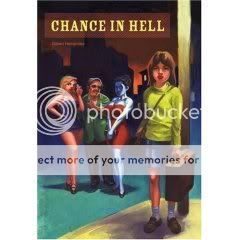
Chance in Hell
Fantagraphics, September 2007
Gilbert Hernandez, writer/artist
120 pages, hardcover
$16.95
Buy it from Fantagraphics
Buy it from Amazon.com
Rough, rough stuff from the creator of Palomar. Hernandez is in the midst of creating graphic novels based on the B-movies that his Palomar-verse character Fritz starred in, but “B-movie” might give you the wrong impression here. This isn’t one of those howlers the bots made fun of on MST3K–it’s the kind of disturbing, unpleasant film starring and shot by unknowns that you might rent on a whim from the horror or European section of your old neighborhood video store, watch, and spend the rest of the evening worried about the mental health of cast and crew. The story concerns Empress, an orphaned toddler abandoned in a sprawling, dog-eat-dog garbage dump and raped so frequently that she doesn’t even seem to notice anymore. A farcical string of bloodily violent incidents leads her to a life as the unofficially adopted daughter of a poetry editor who claims to have come from the same circumstances, and then eventually to a second life as the wife of a young district attorney, but in both cases violence and squalor cling to her like a stench, to use a frequently invoked metaphor.
This is the angriest I can ever recall Gilbert’s art looking. That’s saying something: My wife, for example, finds his books almost difficult to look at–“His characters just look so hard,” she says, and they’ve never been harder than here. Right from the get-go his figures seem dashed off as in a white heat, while several early landscapes and backgrounds in the hellish dump look like the whole world is on fire. His almost supernaturally confident pacing of scenes and the cuts between them evoke in their matter-of-factness the acceptance of everyday brutality by the characters themselves. At times the jumpcuts can be quite funny, as when a scene between Empress and her adopted father consists solely of a pair of panels where they argue over whether a glass is half empty or half full; both Hernandez and his characters know how reductive this exchange is, yet also know it’s quite true to who they are.
But when that metronomic editing slows down, the effect is powerful, particularly because it is often done to draw out scenes of gutwrenching violence or tragedy. (The centerpiece scene in the brothel is as disturbing as the death squad attack in Gilbert’s masterpiece Poison River; there as here a knowing glance is all-important, but here it causes murder rather than prevents it.) The end of the book changes the pacing again, revving up the jumpcuts to suggest unsolved crime and unglued minds, and to be honest I’ve revisited it three or four times today and I’m still not sure what’s going on. Maybe that’s a problem, maybe it’s not. Since I see myself revisiting this book, a gruesome, enraged commentary on just how shitty things can be, many, many times in the future, I’m leaning toward “not a problem at all.”
Comics Time: The Last Call Vol. 1
January 16, 2008The Last Call Vol. 1
Oni Press, August 2007
Vasilis Lolos, writer/artist
144 pages
$11.95
My favorite thing about The Last Call‘s debut volume is that it’s not at all what I thought it would be. I expected the kind of genre mash-up hipster-action/adventure/fantasy story we’ve seen in books like Scott Pilgrim, Multiple Warheads, East Coast Rising, and even Powr Mastrs to a certain extent. That’s where it seems like we’re going at first, as young metalheads Sam and Alec head out for a road trip blasting loud, evil music with hilariously Spinal Tap-esque lyrics that fill their car, and the panels, thanks to Lolos’s clever writing and lettering. Next thing you and they know, they get zapped into another dimension where they’re apparently on board an enormous train filled with monstrous beings who dress and act like characters from Murder on the Orient Express (an obvious influence, along with Paul Pope’s Heavy Liquid, two works not often paired). Then you’ve got to muddle through some claustrophobic layouts, staccato pacing, an unclear sense of place, and a somewhat repetitive choice of facial expressions for poor stranded Sam, who soon becomes our main character. (You definitely miss the levity and variety brought to the table by Lolos’s vivaciously inventive color palette in his Pirates of Coney Island series with Rick Spears.) But just when you think you’ve got the book pegged, there’s a moment when Sam’s sitting down for lunch in the train’s palatial restaurant with an enormous bulldog-jowled, double-mandibled dowager when suddenly you realize that Lolos is tapping another vein of fantasy entirely: the episodic discovery-of-another-world story. Sure enough, charming, slightly menacing characters collide with Sam to his alternating delight and chagrin, like an Alice in Wonderland or an Abarat as drawn by a guy with a lot of tattoos. The pacing gets increasingly clever, the character design and body choreography increasingly expressive, the plot increasingly hooky, and the book increasingly enjoyable. Like his frequent collaborator and real-life S.O. Becky Cloonan, Lolos is an exciting artist who should be a blast to watch as he shakes free of his most direct influences; this book’s a good start in that regard.
Comics Time: Skyscrapers of the Midwest #4
January 14, 2008Skyscrapers of the Midwest #4
AdHouse Books, October 2007
Joshua W. Cotter, writer/artist
56 pages
$5
The fourth and final issue of Josh Cotter’s stunningly self-assured debut comic is kind of like the thesis statement of the series. The rich fantasy lives of the two little brothers, shaped almost completely by the kind of throwaway genre entertainment of the ’80s that proved almost despite itself to be richly resonant with we America’s nerds and losers, virtually replace their emotions rather than be shaped by them. The younger brother’s innocently violent He-Man drama of loss and recovery, the older brother’s violently sexualized late-Marvel drama of emasculation–both larger-than-life sequences all but spill out of their pages and overwhelm the usually staid visuals of the book. In this way they’re like the mystical flood that sweeps away the boys’ grandmother in the mysterious shared vision that gives the series its title. The choice offered to the older brother in this sequence, itself the apotheosis of the mystical realist epiphanies whose singular iconography has given the series much of its power, is to keep a part of himself locked away behind the helmet of his damned superhero idol or face life without that iron mask. As you might know if you’re reading this blog, this comic like all comics is part of an industry where major players profit quite directly from lingering emotional scars and not always in the most scrupulous of ways, so the theme hit me square in the gut. Skyscrapers #4 is both uncondescending and uncompromising in its depiction of how fantasy can be both pleasure and prison. It’s a hard and beautiful book, and aside from a slight misstep involving a too easily provoked and resolved fight between the brothers at the book’s end, which is the kind of thing I’m very forgiving about, it’s a fantastic book too.
Comics Time: Incredible Change-Bots
January 11, 2008Incredible Change-Bots
Top Shelf Productions, August 2007
Jeffrey Brown, writer/artist
144 pages
$15
The best gags in Jeffrey Brown’s loving, lushly colored Transformers parody feel like they didn’t necessarily have to be part of Jeffrey Brown’s loving, lushly colored Transformers parody. A Change-Bot describing, mid-fight and in overly verbose detail, the rigors he went through so as to enjoy pounding the shit out of his enemy…a leopard batting around an origami Change-Bot, then “trot trot trot”ting away with the crumpled bird-bot in its mouth…the evil leader blowing away his underling for the crime of having “perfect aim” that’s “not perfect enough”…all of these jokes play off the same sources of humor–inflated self-worth either rampaging unabated or getting pathetically deflated, imaginations shaped by exposure to genre fiction–present in many of Brown’s gag panels and short, funny stand-alone strips.
The story that links them all together is definitely best appreciated by Transformers fans, and I’d imagine Brown didn’t hope for anything more. That two factions of giant robots waging vindictive war against one another for eons might unwittingly cause massive destruction to themselves and their allies in the process is an idea that even kids could dimly make out beneath the surface of the concept, and Brown brings it to the fore entertainingly, maybe all the more so for its gentleness (Dan Clowes’s “On Sports” this isn’t). He also makes some hay out of the narrative loose ends endemic to these kinds of stories: robots yelling “I can explain!” and never doing so, doomsday buttons that may or may not have been pressed. If anything, I wish he’d laid into some of the Transformer mythos’ weirder elements–those five-headed floating robot tribunal guys, the giant planet-sized robot, the death and rebirth of the two leaders, and so on–but I suppose that would draw it away from the central “two equally stupid and destructive forces are arbitrarily slapped with ‘good’ and ‘evil’ tags and the audience is expected not to notice” thesis.
Ultimately Change-Bots is dumb fun, with the emphasis on both words: Practically every character is an idiot, which limits the book’s depth. But when combined with Brown’s solid character design, blockily effective action choreography, and vivid magic-marker palette, it’s certainly a pip to breeze through, even if I don’t see myself returning to it as often as I do to Brown’s autobiographies, or even most of his other, less franchise-specific humor and parody comics.
Comics Time: Multiple Warheads #1
January 9, 2008Multiple Warheads #1
Oni Press, July 2007
Brandon Graham, writer/artist
48 pages
$5.99
(I hope you’ll pardon me for getting meta for a moment. Normally I think talking about trends when discussing a comic like this is just a substitute for actually discussing the comic, but in this case the meta takes us in a direction my mind’s been wandering in a lot lately anyway.)
I don’t know if it’s fair to credit Scott Pilgrim as throwing wide the doors for projects like these, or if it’s simply the highest-profile such project to pass through said doors regardless of who might have opened them. But at any rate, Multiple Warheads is one of those books like SP that makes you say “hey, this is an exciting time to read comics.” Like a growing number of projects–many from Oni–it’s the product of a North American artist who’s interested in action-based genre storytelling yet has no particular debt to superhero comics, a creature that until recently didn’t exist. In this case the artist is Brandon Graham, and he’s bringing to bear obvious interests in manga, European sci-fi comics, barbarian stories, and porn to create a fast, loose story of a waaaaay post-apocalyptic future where a va-va-voom young lady named Sexica smuggles super-powered organs around a walled-off city inhabited by aliens and werewolves and normal people too. It’s a pretty slight thing. Maybe that’s because the most obvious points of comparison–Scott Pilgrim, East Coast Rising, The Pirates of Coney Island–are all telling book-length stories while Graham’s going done-in-one (and at kind of a hefty price point). Or maybe it’s because the thin line, skewed proportions (everything seems both a bit narrow and a bit bowed), and acres of blank space in the word balloons give the art a tossed-off barely-there feel. Or maybe it’s because the story isn’t really a story per se, it’s more of a “day in the life” kind of thing that simply begins when it begins and ends where it ends, arc schmarc. But the end result of all that slightness is not unpleasant in the, well, slightest. It’s a breezy vibe for a breezy character. Indeed, breeziness is very serious for Sexica, almost a raison d’etre. She wants to go someplace nice, untouched by war, and she’s tried to get there, it seems, through means both intimate (sewing a smuggled wolf dick onto her boyfriend for some extra spark in the sack) and direct (taking advantage of a spaceship crash to get the hell out of Dodge). It’s a laid-back book, almost a stoned book, which makes sense given that Vaughn Bode is evident in Sexica’s every lovingly delineated curve. I enjoyed it, and I’m hoping that future issues will provide some muscular mind-expansion–something along the lines of the beautiful panel that communicates Sexica’s post-coital bliss at being surrounded by the comforts of home with a bed’s-eye-view of the bulbous light fixture on the ceiling above her–to deepen and enrich the pleasures of this installment’s lovely but fleeting buzz.
Comics Time: Batman by Josh Simmons
January 7, 2008Batman
self-published
Josh Simmons, writer/artist
16 pages
Read it for free at joshuahallsimmons.com
This haunting, completely unauthorized take on Batman begins with what may be the best first panel of a comic I’ve seen in the past year: A crazed jumble of a cityscape whose non-Euclidean geometry resembles something out of The Cabinet of Dr. Caligari threatens to overwhelm the panel borders and spill out all over the reader, while a caption box identifies it, simply and confrontationally, as “Gotham City.” That sets the tone for what follows–a disturbing, uncomfortable response to the Batman concept. What really knocks me out is just how many different levels it works on. It could be a horror comic in about a human monster in the Henry/Buffalo Bill/Leatherface vein. It could be a blackly humorous, satirical pisstake on the Caped Crusader. It could be a vicious assault against the reactionary politics of the superhero. It could be an angry riposte to the ever-grittier direction superhero comics are headed in. It could be an exercise in drawing action and environments. Most amazingly, it could be a great Batman comic, period–Batman’s rooftop and skyscraper milieu is depicted with genuine awe, the physical particulars of his methods are choreographed impeccably (as good as any comic this side of Paul Pope’s Batman Year 100), and the story is totally convincing as an examination of what might happen if Batman, worn down by the weight of years of horror and toil–“I’ve been Batman for a long time,” he repeats–finally snapped. As in his horror graphic novel House, Simmons’ art excels in conveying the way the sheer size of environments both natural and manmade can be frightening, and as his inks shift back and forth from woodcut chunkiness to manic clarity, the effect is practically palpable. The pacing is ruminative but never plodding, lingering just a bit too long, making you feel like something is off but never tipping its hand till the story demands it. Clever bits of business involving Catwoman’s acrobatics and the passing of a nearby plane add pizzaz to an extremely dark affair. Even Simmons’ figures, never his strong suit, have the mitigating factor of masks and costumes working in their favor. And on a meta level, it’s just exciting to watch an artist steal a major corporate icon because he’s got something to say and needs him to say it. This is a hard comic to shake, so thank goodness I have no intentions of trying to do so.
Comics Time: Powr Mastrs Vol. 1
January 4, 2008Powr Mastrs Vol. 1
PictureBox Inc., November 2007
C.F., writer/artist
120 pages
$18
It might be the jellyfish-on-human double-penetration tentacle-sex scene that makes you realize that this is an adult fantasy comic, but that label, “adult,” is really present throughout this first in a projected series of chronicles of the land of New China. For all that characters like Subra Ptareo may be on a quest and Mosfet Warlock may be a mad scientist, their interlocking stories (so far) don’t read like the genre narratives of my youth beyond their fantastic trappings at all. Instead, they’re stories about buying things and selling things, about twentysomethings (or at least twentysomething analogues) meeting new people and flirting with them, about getting stoned, about fucking and deceiving the people you fuck, about being moved to tears by the realization that you’re actually good at what you’ve chosen to do with your life. Where the fantasy really comes in, for me at least, is in the art. C.F.’s simple, childlike line is reminiscent in affect and effect of Frank Santoro’s in their mutual publisher’s Cold Heat, but while the latter relies on open spaces and canny color choices to evoke the both the supernatural and the mental states akin to it, the former gets it done with detail. The result is always shocking, whether a sudden splash page overripe with flowers and foliage or a doggystyle-eye-view close-up of a tentacle-filled vulva. The word I’m really looking for here is psychedelic, not the cheesily amorphous lowest-common-denominator version but the intense wall-of-sound riot of art-information present in a Moscoso font or the crescendo in the Beatles’ “A Day in the Life.” The combination results in as fecund a playground for the imagination as a far more traditional fantasy story, but arrived at from a totally different direction. It’s inspiring.
Comics Time: Kid Eternity
January 2, 2008Kid Eternity
DC/Vertigo, February 2006
Grant Morrison, writer
Duncan Fegredo, artist
144 pages
$14.99
So this must be one of those “minor works” I always hear so much about. Collecting the three-issue 1991 Vertigo “reimagining” of some old DC character, Kid Eternity reads like many a current comic really intended as a movie pitch rather than a reading experience: A hapless everyman is inducted by a glib, ubercompetent, superpowered cool dude into the secret truth behind the world as we know it. The pleasures to be had here are in the idiosyncratic details Morrison weaves into this shopworn plot: casting said everyman as an observational stand-up comic (his name, Jerry Sullivan, evokes a Seinfeld with an Irish-Catholic’s hang-ups instead of a Long Island Jew’s); making said secret truth a weird (if familiar) splatterpunk take on Dante’s Inferno; harnessing artist Duncan Fegredo, who currently mimics Mike Mignola in the pages of Hellboy, to the yoke of the world’s lengthiest Dave McKean impression. But the curveballs failed to keep me as too many of the surrounding pitches were predictable and almost half-hearted. Serial killer? Check! Deranged Christian missionary? Check! Crazy lettering? Check! Tarot cards? Big check! Fegredo’s visuals feel similarly lackluster: For every memorably wild vista (his infernal architecture is particularly ambitious) there’s a murky, difficult-to-follow action sequence (I’m still not quite sure what happened in that initial bloodbath), hard-to-distinguish supporting character (I didn’t notice that there were two separate murderous antagonists for Jerry and the Kid until they started attacking one another), or just generally uninspired choice (a would-be mindblower tour of hell is metonymized by a few static stand-alone panels and one image seemingly picked at random to anchor the spread in the background). Morrison’s at his best when his comics either really read like comics (Arkham Asylum, All Star Superman) or look like comics (We3, I dunno, Seven Soldiers), and this comes across as a creature of its era that thinks it’s too cool for school to do either, which it isn’t.
Dan, just admit it… (or: a spoiler-filled analysis of Eightball #23)
June 29, 2004Foreword: Petty patronizing hyperbole aside, my pal Milo’s recent posts on the preponderance of superhero-centric writing in the comics blogosphere has had at least one positive effect: convincing me to get off my duff and blog more often about alternative/art comics. But the altcomic that I’d like to talk about today also happens to be a superhero comic. Dramatic irony, or poetic justice–you make the call! Also, SPOILER ALERT.

Eightball #23
Daniel Clowes
44 pages, full color, $7.00
Fantagraphics
Okay. When I said Daniel Clowes’s new comic, Eightball #23: The Death-Ray was a superhero comic, I was exaggerating a bit. Oh, sure, it’s an explicit response to the genre–a critique, even–but it properly belongs to another maligned type of genre fiction: the serial killer narrative. The superhero trappings throughout this pitch-black work provide an easy in for discussion, not to mention one of Clowes’s trademark meta-references to the history and ephemera of the medium in which he is so alarmingly proficient, but in the end The Death-Ray is about superheroes in the same way that The Silence of the Lambs is about psychiatrists. The professional inspiration of the killer is interesting, but it’s the fact, the existence, of unflinching, unreflective evil that’s the point.
The Death-Ray‘s protagonist is Andy, to whom we are introduced when he’s a twice-divorced middle-aged dog owner, but whom we mostly follow during his years in high school. (In fact, we’re not even sure we’re following the same guy, at least initially; I had to go back and reread the opening high-school sequence (“The Origin of Andy”) before I realized that the brown-haired, skinny kid in it was, in fact, not a girl.) Andy is a quiet, nondescript kid of no discernible social strata in his school, whose only friend is bespectacled, somewhat arrogant crypto-Nietzschean student named Louie. Raised by his aging and ailing grandfather following the deaths of his father, mother, and grandmother, Andy discovers upon smoking a cigarette (one he initially thought must have been laced with PCP) that he gains superhuman strength with the introduction of nicotine into his bloodstream. A letter addressed to him from his late scientist father explains that this incredible power is a result of an experimental hormone he treated Andy with during his childhood. It also reveals the existence of another experimental weapon: A yellow gun resembling a science-fiction blowdryer, that fires something referred to by Andy’s dad as a death-ray. We soon learn that when Andy (and only Andy) pulls the death-ray’s trigger, whatever he aims it at is erased from the face of the Earth. With the advice and encouragement of Louie (who, following a trip to New York City, has become enraptured with the exhibitionistically angry punk movement), Andy sets about finding a way to use his newfound powers for good, in pursuit of the “something big” for which he feels his tragedy-laden life has destined him.
And oh, geez, where to go from there. Eightball #23, like its predecessor #22 (Ice Haven), is a staggeringly rich and dense work. Like #22, #23 is divided into numerous subsections of varying artistic styles, each with its own old-fashioned sub-title. Unlike #22, though, #23’s subsections would be difficult to understand if read on their own; the individual titles are less a mechanism of the paradigmatic writing method involved in the previous issue (in which individual vignettes about various characters cohered to tell an overall story, a la Altman) and more a convenient method of simultaneously transitioning from one scene to another, setting up and/or commenting on the scene at hand, and tying the entire work back to the superhero and melodrama genres with which Clowes is constructing his new work.
Primarily drawn in a slightly looser, sketchier style than is customary for Clowes, the art of The Death-Ray conveys a sense of terrible urgency, as though this was a story Clowes felt he had to tell as soon as possible. (This despite the two-year gap between issues—it sure doesn’t feel like it’s been that long.) Switches between one style and another are not done with the rigorous regularity of #22; there’s less of a sense of “I’m aiming for something different with this section” and more of “this is just the most efficient way for me to keep the story going at this clip.”
The primacy of the need to get this story out is reinforced within the narrative itself by the way Clowes has Andy, the book’s narrator and in almost every scene its focal character, tell us the story. Rather than using traditional thought balloons or thought caption boxes, Andy’s thoughts and narration are contained in actual word balloons. There is a slight difference between the balloons that contain narration/interior monologue and the balloons that contain actual—the former are slightly rectangular, the latter have the usual rounded shape—but the overall effect is that wherever Andy goes, whatever Andy does, his personal view of the world is not just inescapable but dominant. It’s a brilliantly evocative technique, familiar to any reader who’s ever gone through the motions of interaction with others yet spent the whole time in his or her own head. (As Andy puts it, not of his way of thinking but of his use of his superpowers, “somebody has to impose some kind of structure on the world, I guess. Otherwise everything would just fall apart, wouldn’t it?”)
Andy, then, is very much the star of his own movie. That is also one of the themes of the book: The degree to which pop culture molds individuals’ expectations of themselves. Andy’s adoption (largely at Louie’s behest) of a superhero’s costume and vigilante techniques make next to no sense given Andy’s actual life experience, even given the incredible introduction of superpowers into it; after all, Andy surmises that his father simply intended for his son to become as strong as the athletic kids in his grade and “turn myself into the most popular kid in school.” It’s the boys’ exposure to funnybooks and, one assumes, the Batman TV show, that convinces them to use Andy’s super-strength and death-ray to fight crime, such as it is. The multiple sub-titles that Clowes assigns various sections of the book—”ON PATROL,” “THE FURTHER ADVENTURES OF THE DEATH-RAY,” “THE LAST STRAW”—further drive home the artificially constructed nature of Andy’s self-perception. Moreover, the occasional sequence depicts Andy and Louie swinging along city rooftops and battling crooks in the traditional superhero manner, even as they themselves continue discussing the far more quotidian battles in which they’re engaged. (The occasional “Right again, old chum!” is thrown in, but only to demonstrate the depths of the budding psychosis; we know that this was not spoken aloud, but it’s no less an accurate depiction of Andy’s mindset for that.) And it’s not just mass, mainstream culture that’s to blame, by the way. Louie’s cookie-cutter punk outlook is as much a catalyst in the terrible events that follow as is the boys’ familiarity with superhero tropes, since it gives Louie’s preexisting contempt for nearly everybody a cultural framework in which to thrive. Punk does little more for Louie than providing him an avenue to get laid, making him a bigger asshole than he already was, and giving him an excuse to pick fights—which he then cites as proof that other people are assholes who deserve what they get.
Indeed, the real problem besetting Andy and his supposed sidekick is the arbitrariness of their actions in combating crime and bad people. Simply put, the disconnect between the crimes committed and the punishment Andy and Louie dish out is so great that the act of punishment itself becomes meaningless. Andy and Louie use a discarded wallet as bait, then bully the impoverished man who picks it up, committing a “crime” that couldn’t even have occurred without the boys’ intervention. Andy roughs up a couple of burglars who he spies running off with an old man’s TV set, but even before he catches up with and knocks the snot out of them, they’ve dropped the TV, destroying it; it’s clear from the old man’s expression that he can’t afford to buy another. A girl Louie has the hots for gets smacked around by her father; Louie and Andy beat the man, but do so as he’s walking the girl’s beloved dog, who runs away, thus making her even more upset. Louie constantly tries to persuade Andy to have at a high-school meathead named Stoob with whom Louie has a long-standing and incredibly stupid grudge; it gets to the point where Louie lies on the sidewalk motionless in front of Stoob in hopes that the kid will kick him, in order to “prove” that Stoob deserves to die. In a sequence that quietly hits home for the grown-up Andy, a bartender is rude to a man who’s drinking because his grandmother died that day; Andy subsequently beats the oblivious barkeep to a bloody pulp. The beginning of the end for Andy and Louie occurs when Louie’s resentment toward his sister Teresa’s drug-dealing boyfriend leads the boys to indulge Teresa’s ex’s semi-veiled request to take the man out permanently. As Louie, abuzz with newfound moral qualms, puts it to Andy after the event, “You know, C.J. was an asshole, but he didn’t deserve to die. You didn’t even know the guy.” This from the kid who came up with the whole idea in the first place, as Andy immediately points out to himself. Louie may have had enough, but by now Andy is too far gone, too attached to the notion that he finally has the ability to “impose structure on the world,” to stop.
So at last we come to the heart of Eightball #23’s darkness: We’re witnessing the birth of a serial killer. Murder has never been far from the surface of Clowes’s work—with the exception of Ghost World, all his major works have contained violence or the threat of violence—but this is his most thorough (and not coincidentally his bleakest) examination of the subject to date.
The day before I bought this comic, I used my employee discount to pick up Michael Newton’s The Encyclopedia of Serial Killers. In it, Newton quotes a jailhouse monologue from prolific serial murderer Henry Lee Lucas:
It’s a damn shame about people, it really is. We are surely the ugliest creatures in all of nature. Look at you: What have you ever done? What gives you the confidence to sit there with a smirk on your face like you’re better than me? You think anybody cares about you? Guess what—they don’t. You can lie to yourself all you want, but the rest of us are wise to your scam. You should have been an abortion or sold into slavery. Who gave you the right to take up space in my world? I’ve never done anything to anyone they didn’t deserve. My justice is nothing if not merciful. Does that mean I’m soft? Hell no. You think I’m afraid to erase you from the landscape? Look, I know what you’re thinking. Hell, maybe you’re right. It’s a lot of responsibility, but I’m not one to complain. I’ve got a job to do like everyone else. Who am I? Your worst nightmare.
Chilling, horrifying…and fictional. That wasn’t Lucas at all, but our hero Andy, toward the end of the book, in one of the strongest sequences Clowes has yet created. Throughout this grotesque monologue the present-day, middle-aged Andy’s “mask of sanity” remains intact: He returns from the grocery store, puts away his food, strolls over to his closet, reaches inside, walks up to his apartment building’s roof, surveys the green below him, eats his TV dinner. It’s only just now, after several readings of the book, that I’m realizing that the thing he reaches into his closet to grab is the death-ray, that his talk about “eras[ing] you from the landscape” is no idle chatter, that the bell-shaped silhouette in the eighth panel of this sequence is not the doorknob to Andy’s apartment but the muzzle of the death-ray as outlined against the evening sky, and that the man sitting on a park bench below Andy (the appearance of whom made me nervous, in a Charles Whitman-referencing sort of way, but little more) has just become his next victim. The insipid banality of the Rambo quote that ends the passage merely heightens the horror: Andy has no real insight into why he does what he does beyond the cheesy vigilante morality of Hollywood.
And this momentous act is not the only one that happens in a caesura. At the end of the book we see a partial line-up of Andy’s victims, answering the section’s sub-title’s question, “Why did Andy destroy you?” We learn that the two divorces Andy has spoken of having were caused by men with whom Andy’s wives cheated, men who Andy then murdered. We learn that a brief conversation between the teenaged Andy and his housekeeper, in which the housekeeper implied that her daughter had been taking drugs, led to the execution of a man whose crime was nothing more than selling the daughter some weed. In the same way that the disturbing crime at the heart of Eightball #22, as well as its resolution, took place between the panels, so too do many of the killings in #23. It’s as though, to our central character, they’re hardly worth mentioning—the events he does choose to depict are assumed to be explanation enough. Given the circumstances, Andy seems to suggest, any one of you would have done the same.
As with nearly all serial killers, sex is a key component of the killings, although not as obviously as with some. Most serial murderers hunt within the gender to which they are sexually attracted (as an aside, this gives lie to the notion that The Silence of the Lambs is homophobic: Buffalo Bill is not gay at all, but a woman-hater whose transsexualism is intended as a mockery of both homosexuals and women; we even see Polaroids of the guy with strippers at one point). This is not the case with Andy, as near as we can tell’he maintains an idealized long-distance relationship with his “girlfriend,” Dusty (“I hadn’t stopped loving her—and still haven’t to this day, come to think of it,” he says 24 years later, though once again this is likely just an attempt to assign meaning to a life where none has truly existed). But he displays true, romantic feelings (which it nonetheless appears he is trying to hide from the reader; he never describes them to us, and the one time he does address them directly in the context of a dream about having sex with her, he talks to her (“you”) directly) toward his African-American housekeeper. Clowes clearly wants us to see this attachment as an integral part of what makes Andy into what he becomes. The key sequence in which Andy discovers the truth about his superhuman inheritance from his father, “THE ORIGIN OF THE DEATH-RAY,” begins with two panels of disembodied sexual dialogue (“Fuck me, Andy!” “Yeah, baby—that’s it!”), and eventually includes yet another (“Oh Andy, you fuck me so good!”). It’s not until two-panel daydream sequence pages later that we learn the idenity of speaker: Dinah, the housekeeper who keeps the place from falling apart as Andy’s Pappy becomes more infirm. Andy eventually makes his feelings for Dinah clear to her by attempting a kiss; by the very next panel, she’s gone, and the placement of this sequence just before the most traumatic one in the book implies a causal relationship between Andy’s actions in the former and his actions in the latter.
Similar goals influence Louie’s behavior. Right after a scene in which he and Andy discuss their lack of superheroic motivation (“Look at the Hulk—his wife died, or something”), Louie spots the girl on the basis of his crush on whom he and Andy would later assault her father. It’s Louie’s later discovery of a pretty punkette that leads to the moral conversion that catastrophically unravels his relationship with Andy. (Yes, the “one friend in the world” the grown-up Andy refers to is not Louie, to our surprise.) Moreover, nearly all of the victims of Andy we know of have some sexual connection to him, whether they’re the men who ‘fucked his wives” or the dealer who sold grass to his beloved housekeeper’s daughter. And finally, of course, there’s the unspoken sexual dimension of Andy and Louie’s relationship itself. Paired killers are not at all uncommon, from the Hillside Stranglers to Henry Lee Lucas and Ottis Toole, and often the killings serve to consummate the sexual tension that the killers themselves aren’t (or, sometimes, are) willing to consummate themselves. It’s no coincidence that, just before Andy and Louie’s traumatic “break-up,” Louie seems to have found an actual girlfriend and Andy has finally acted on his love for Dinah. The two don’t need each other anymore. (It’s also no coincidence that the one scene we see without the interceding viewpoint of Andy is of a weepy Sonny, Louie’s sister’s lovelorn ex-boyfriend and the man whose desire to win her back sets the ultimate breakdown between Andy and Louie in motion. In the world of serial murder, love and death are inseparable.)
Of course, Clowes’s usual pitch-black insights into the human condition are omnipresent. Whether it’s Pappy’s cri de coeur (“Oh God, why can’t I remember things?”) and his inability to recall that his wife Sarah has died (“Dear S” reads his unfinished letter to her); Andy’s “girlfriend” Dusty’s tragicomic pose with a garden hose, using it as a microphone, lipsyncing to the radio with braces on her teeth; carrot-topped Stoob’s sensitive acoustic-guitar wooing of a pretty girl; Louie’s pre-NYC assessment of punk music (“You like this?” “I dunno…I think so. It makes me want to kill somebody.”); the fact that the mechanism Andy’s dad chose to activate his latent superpowers will likely give him lung cancer….You’ve got to laugh to keep from crying. It all culminates Andy’s closing address to the reader, delivered on what we assume is the Fourth of July after a run-in with a grown-up Stoob (you can insert the de rigeur “It’s about Iraq!!!” reading here, if you absolutely must):
He couldn’t fool me. Underneath it all, he was still the same guy. Nobody ever changes.
That’s not to say that everybody’s an asshole. I know better than that. Hell, you’re probably a decent person yourself. There are plenty of you out there.
For you, Mr. and Mrs. Decent Citizen, I’ll do anything. Just say the word.
You’ve got a friend in old Andy.
Of course, we don’t. But in the same way that Andy’s thoughts superimpose themselves against the events of his life, it’s Andy’s view of The Way Things Are, not ours that has the final say. Andy’s among us, and we’re his one friend in the world. Maybe he is our worst nightmare, after all.




